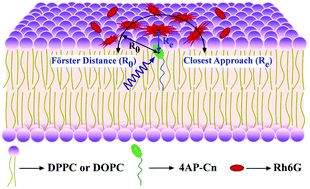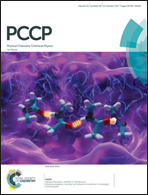Probe-location dependent resonance energy transfer at lipid/water interfaces: comparison between the gel- and fluid-phase of lipid bilayer†
Abstract
Despite significant interest in understanding the role of the local dielectric environment and lipid-bilayer fluidity/rigidity in resonance energy transfer between chromophores at lipid/water interfaces, a comprehensive approach to quantify such environmental dependence on energy transfer is missing – primarily because of the scarcity of suitable probes. Here we present the results on multi-chromophoric Förster resonance energy transfer (FRET) from a series of 4-aminophthalimide-based molecules (4AP-Cn; n = 2–10, 12) of different lipophilicity (donors), which reside at different depths across the lipid/water interfaces, to rhodamine-6G (Rh6G; acceptor) molecules that stay in a water-rich region near the lipid headgroups. We apply steady-state and time-resolved fluorescence spectroscopy, and find that multi-chromophoric FRET from the series of 4AP-Cn donors to the Rh6G acceptor occurs in a peculiar stepwise fashion at the lipid/water interface of a gel-phase (Lβ′) DPPC (1,2-dipalmitoyl-sn-glycero-3-phosphocholine) bilayer at room temperature. However, the same donor–acceptor pairs show only subtle but continuous donor-depth-dependent FRET at the lipid/water interface of a fluid-phase (Lα) DOPC (1,2-dioleoyl-sn-glycero-3-phosphocholine) bilayer. These features were found to correlate with the lipid-phase dependent local environmental polarity sensed by 4AP-Cn donors at the interfaces. Molecular dynamics (MD) simulations, combined with experimental results, show that relative depth (and angle) variation of the 4AP-Cn donors and Rh6G acceptor directly controls the FRET efficiencies through fine tuning of the emission and absorption spectra of the donors and acceptor, respectively. The results indicate that the 4AP-Cn probes are well-suited as donors for FRET studies, which allow the FRET parameters at lipid/water interfaces of gel- and fluid-phases of lipid-bilayers to be quantified and compared simultaneously.



 Please wait while we load your content...
Please wait while we load your content...